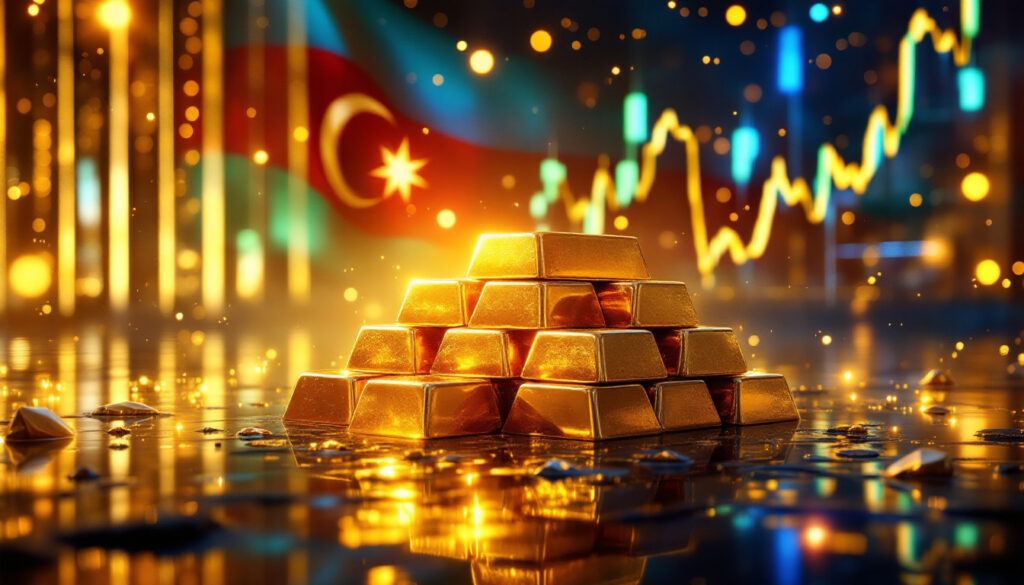How Much Gold Did Azerbaijan State Oil Fund Purchase in Q1?
Azerbaijan's Recent Gold Acquisition
Azerbaijan State Oil Fund made headlines with its substantial gold acquisition in Q1 2023, adding an impressive 18.7 tons of gold to its reserves. This strategic move has significantly bolstered the fund's precious metals holdings, which now exceed 165 tons in total. What's particularly noteworthy is that gold now represents more than 25% of the fund's entire portfolio, highlighting the growing importance of this asset class in sovereign wealth management.
The scale of Azerbaijan's commitment to gold is remarkable when compared to global standards, positioning the State Oil Fund among the more aggressive sovereign entities in terms of gold market analysis. This shift represents a calculated diversification strategy that prioritizes tangible assets with intrinsic value over traditional financial instruments.
Significance of Azerbaijan's Gold Strategy
Azerbaijan's substantial gold purchases are not occurring in isolation but rather represent part of a broader global trend among sovereign wealth funds and central banks. Since 2022, central bank gold trends have resulted in approximately 1,000 tons of gold annually being added to their reserves, demonstrating a significant shift in institutional attitudes toward the precious metal.
As Florian Grummes, Managing Director of Midas Touch Consulting, explains: "Gold is being remonetized into the system. Since 1971 and the end of the gold standard basically when Nixon closed the gold window, gold has been moving out of the system more or less. And now we've seen more and more demand from central banks especially of course from China, but also sovereign wealth funds are now buying into it."
This strategic pivot by Azerbaijan demonstrates a deliberate move away from excessive reliance on traditional reserve assets, particularly US dollar-denominated holdings. The fund's actions mirror similar strategies implemented by other resource-rich nations seeking to protect national wealth from currency devaluation and geopolitical uncertainties.
Why Are Central Banks and Sovereign Funds Accumulating Gold?
Gold Remonetization Trend
The concept of gold "remonetization" represents a fundamental shift in the global financial landscape. After the Nixon administration severed the dollar's convertibility to gold in 1971, the precious metal's formal role in the monetary system diminished considerably. However, what we're witnessing now is a gradual reintegration of gold into the financial framework, albeit in a different capacity than its historical role under the gold standard.
According to Grummes, this trend is still in its early stages – "in the first or second inning" – suggesting that the movement toward gold as a strategic reserve asset has substantial room for growth. The reemergence of gold's monetary significance is occurring against a backdrop of unprecedented monetary experimentation by central banks, including negative interest rates, quantitative easing, and ballooning sovereign debt.
Central bank gold purchases reached 1,136 tons in 2023, marking the second-highest annual total since 1950. This data point underscores the acceleration of the trend, with sovereign institutions increasingly viewing gold as an essential component of their reserves.
Strategic Motivations
The motivations driving Azerbaijan State Oil Fund and other sovereign entities toward gold are multifaceted and strategic. Primary among these is gold's historical role as a hedge against currency devaluation and inflation. As central banks worldwide expanded their balance sheets dramatically following the 2008 financial crisis and the COVID-19 pandemic, concerns about the long-term purchasing power of fiat currencies have intensified.
Gold's 10-year annualized volatility of approximately 13% compares favorably to equities (18%) and cryptocurrencies like Bitcoin (65%), making it an attractive stabilizing force within diversified portfolios. For oil-producing nations like Azerbaijan, gold offers protection against the inherent volatility of hydrocarbon revenues.
Additionally, gold provides a means of diversification away from US dollar-denominated assets, which have traditionally dominated sovereign reserves. This shift reflects growing concerns about the sustainability of US fiscal policies and the potential for dollar depreciation over time.
The physical nature of gold, requiring no counterparty for value, offers protection against geopolitical instability and sanctions risks – a consideration that has become increasingly relevant in recent years. Russia's central bank, for instance, converted approximately 40% of its foreign exchange reserves to gold following the 2014 sanctions, demonstrating the metal's utility as a sanctions-resistant asset.
What's the Gold Price Outlook Following Record Highs?
Recent Price Action and Pullback
Gold has experienced remarkable price action, recently reaching a record high of $3,509 per ounce before experiencing a significant pullback. The market has demonstrated unusual volatility, with daily price swings of $100-200 becoming increasingly common – a level of price movement previously considered extreme but now part of the "new normal" in gold trading.
The increased volatility reflects growing institutional participation and sovereign buying, alongside traditional investment and jewelry demand. At the time of Grummes' analysis, gold was trading around $3,300, having retraced from its all-time high but remaining well above historical support levels.
These dramatic price movements come after gold established a solid uptrend lasting approximately 2.5 years, beginning from the $1,615 low observed in autumn 2022. The magnitude of this advance – more than doubling in value – highlights the structural strength of the current gold bull market.
Long-Term Price Projections
Despite recent volatility, Grummes maintains a decidedly bullish long-term outlook for gold, with a target of $9,000 per ounce. This projection represents a potential tripling from current levels and would constitute an unprecedented price level for the precious metal.
More immediate price targets include the $4,000 and potentially $5,000 levels, suggesting substantial upside potential even before approaching the long-term objective. These projections are supported by fundamental factors including continued central bank buying, persistent inflation concerns, and the ongoing remonetization trend discussed earlier.
On the support side, Grummes identifies $3,000 as a significant psychological and technical level, with a potential pullback to approximately $3,175 representing a "gap fill" in the price chart. The 200-week moving average around $2,800 provides additional macroeconomic support, reinforcing the underlying strength of the current bull market.
Historical context supports the potential for dramatic price appreciation, as the 1970s bull market saw gold rise approximately 2,300% from $35 to $850 per ounce amid stagflationary economic conditions. The 2020-2024 rally has already produced gains of approximately 120%, fueled by pandemic-related monetary stimulus and banking sector instability.
Technical Factors Affecting Price
Technical analysis of the gold market reveals several important patterns influencing near-term price action. Grummes identified a potential head and shoulders formation that could indicate a short-term top in the market. This classic technical pattern, if confirmed, would suggest the possibility of a corrective phase before resuming the uptrend.
Specifically, Grummes noted that if gold cannot exceed the $3,370 level, there may be room for a decline toward the $3,170 area. This technical perspective provides traders with concrete price levels to monitor for confirmation of either bullish or bearish near-term scenarios.
Despite these technical considerations, physical gold demand remains robust across both institutional and retail channels. This underlying demand provides fundamental support for prices even during technical corrections, creating a potential floor for significant drawdowns.
How Is China Challenging the US Dollar System Through Gold?
China's Gold-Backed Yuan Strategy
China has been implementing a sophisticated strategy to expand the international role of the yuan, with gold playing a central role in building trust in the Chinese currency. A key component of this approach involves the People's Bank of China's initiative to establish overseas warehouses for the Shanghai Gold Exchange, creating physical infrastructure for yuan-denominated gold trading beyond China's borders.
This ambitious project aims to expand the use of yuan-denominated gold contracts globally, providing trading partners with a practical alternative to dollar-denominated precious metals transactions. To further support this transition, China has been actively encouraging its state-owned enterprises to settle overseas transactions in yuan rather than dollars.
The integration of China's Cross-border Interbank Payment System (CIPS), which processed approximately $12 trillion in 2024 (though still substantially less than SWIFT's $150 trillion), with gold settlement mechanisms creates a comprehensive framework for non-dollar international trade. Additionally, the People's Bank of China's blockchain-based digital yuan project includes integration with gold settlement options, potentially allowing for frictionless conversion between digital currency and physical gold.
Shanghai Gold Exchange vs. Western Markets
A fundamental distinction between China's approach to gold trading and Western markets lies in the physical nature of Shanghai Gold Exchange transactions. Unlike COMEX and the London Bullion Market Association (LBMA), where paper contracts can significantly outnumber physical metal, the Shanghai Gold Exchange trades exclusively in physical gold.
Grummes highlights the stark contrast: "Western markets may have 200-250 paper ounces for each physical ounce." This leverage ratio creates potential vulnerabilities in the Western gold market structure that China appears determined to avoid by maintaining a strict physical delivery standard.
By offering trading partners the option to settle transactions in physical gold, China provides a compelling alternative to Western paper gold markets. This approach resonates particularly with nations seeking to reduce exposure to potential counterparty risks inherent in highly leveraged paper gold systems.
Perhaps most significantly, reports suggest that Saudi Arabia can now use yuan received from oil sales to acquire physical gold directly in Shanghai. This arrangement creates a complete circuit for oil producers to convert commodity sales into physical precious metals without touching the US dollar – a development with profound implications for international trade.
Strategic Implications
China's gold strategy represents a direct challenge to US dollar dominance in international settlements. By building alternative payment systems anchored by physical gold, China offers trading partners a credible option for conducting international business outside traditional dollar channels.
Gold serves as a crucial bridge in this system, building confidence in the yuan for international settlements. Trading partners who might otherwise be hesitant to hold significant yuan reserves may find the option to convert seamlessly to physical gold sufficiently reassuring to participate in China's alternative payment framework.
This approach forms part of a broader de-dollarization trend in global trade, with notable examples including Iran's acceptance of yuan-gold oil payments in 2023 as a means of circumventing US sanctions, and the BRICS nations' 2024 proposal for a gold-backed trade currency. These developments suggest China's strategy is gaining traction beyond bilateral arrangements.
The situation creates potential audit discrepancies in Western gold markets, as physical metal flows eastward. For instance, 2023 saw significant outflows from London LBMA vaults to the New York Federal Reserve, potentially indicating stress in the paper gold system as physical delivery demands increase.
What's Happening with Silver Compared to Gold?
Current Silver Market Dynamics
The silver market presents several compelling dynamics for investors, beginning with the gold-to-silver ratio exceeding 100 – a historically extreme level indicating silver's potential undervaluation relative to gold. This ratio stands well above its 10-year average of approximately 70:1 and dramatically higher than the metal's natural occurrence ratio of about 10:1 in the Earth's crust.
Physical silver inventories on the Shanghai Stock Exchange have reached an 8-month low, highlighting tightening supply conditions in Asia's largest precious metals market. This inventory drawdown occurs against the backdrop of a silver market that has been in deficit for the past four consecutive years, with a cumulative global supply shortfall estimated at 500 million ounces.
Perhaps most remarkably, silver continues to trade below its 1980 high of $50 per ounce – making it one of the few commodities not to have established new nominal price records over this extended timeframe. This price anomaly persists despite significant currency debasement over the intervening decades, suggesting substantial catch-up potential.
Silver Price Projections
Grummes provides specific silver price targets, forecasting the metal to reach $40-50 by late spring or early summer of 2025. This projection would represent an approximate doubling from current levels and potentially challenge silver's previous all-time high.
Looking further ahead, Grummes identifies longer-term potential for silver to reach $90-100 based on a cup and handle pattern evident on long-term price charts. This technical formation is considered highly reliable in predicting major breakouts and would represent an unprecedented price level for the metal.
The $50 mark represents particularly significant psychological and technical resistance, having formed the peak in both 1980 and 2011. A decisive break above this double-top formation would likely trigger accelerated upside momentum as decades-long resistance gives way.
For context, silver's price action during the 2020 COVID market crash demonstrated its volatility, with the metal falling to approximately $11 per ounce before staging a dramatic 150% rally in just five months. This historical precedent underscores silver's potential for explosive price movements once upside momentum becomes established.
Why Silver May Outperform
Several structural factors support the case for silver potentially outperforming gold in the coming cycle. Industrial demand for silver continues to increase alongside investment demand, creating dual drivers for price appreciation. The metal's essential role in solar panels, electric vehicles, and electronics creates sustained baseline consumption regardless of investment flows.
Supply constraints represent another bullish factor, with few new silver projects coming online to offset growing demand. The development timeline for new mines has extended dramatically from the historical norm of 8-10 years to the current 15-17 years, primarily due to enhanced environmental permitting requirements and community engagement processes.
Physical demand remains particularly strong in China and India, with the latter's 2024 silver imports surging approximately 40% year-over-year on robust jewelry demand. This Eastern physical buying provides a solid foundation for prices even during periods of Western investment outflows.
The increasing integration of silver into green energy technologies suggests continued industrial consumption growth, with approximately 100 million ounces required for each terawatt of new solar capacity. As global renewable energy targets accelerate, this source of demand appears poised for substantial expansion.
How Are US-China Trade Relations Affecting Precious Metals?
Potential US-China Trade Deal
Recent developments in US-China relations have introduced new variables into the precious metals equation. Treasury Secretary Scott Bessent made headlines by mentioning an "opportunity for a big deal" with China, suggesting potential for reduced trade tensions between the world's two largest economies.
Adding to this narrative, statements from former President Trump signaled a potential moderation in his previously aggressive stance on China tariffs. This evolution in positioning has led to speculation about a new trade deal framework that could significantly reshape global capital flows.
Such an agreement, if realized, would represent a substantial shift from the confrontational trade policies that characterized much of the previous administration. The potential easing of tariffs and trade restrictions could have wide-ranging implications for global supply chains, inflation expectations, and by extension, precious metals markets.
Impact on Gold and Silver
The relationship between US-China trade dynamics and precious metals prices is multifaceted. In the short term, any significant easing of trade tensions could introduce volatility into gold and silver markets as investors reassess inflation expectations and safe-haven demand.
A substantial trade agreement might temporarily reduce perceived geopolitical risks, potentially creating headwinds for gold prices in the immediate aftermath of an announcement. However, Grummes suggests that the long-term fundamental drivers supporting precious metals would likely outweigh these short-term reactions.
Gold prices already appear to be discounting potential monetary policy shifts, including expected interest rate cuts and stimulus measures from major central banks. These monetary factors tend to exert more sustained influence on precious metals than trade developments, which often produce shorter-duration market impacts.
The structural factors supporting both gold and silver – including sovereign buying, physical delivery demands, and ongoing currency debasement – create a robust foundation for prices regardless of near-term trade headlines. Additionally, any deal that accelerates global economic activity could enhance industrial demand for silver, potentially offsetting any reduction in its safe-haven appeal.
What's Happening with Mining Stocks in the Gold and Silver Sector?
Current Mining Industry Dynamics
The mining sector presents a stark contrast between operational performance and market valuation. Major gold producers are experiencing "exploding margins" at current metal prices, generating substantial cash flow that enhances their financial flexibility and balance sheet strength.
Despite this robust operational performance, many mining companies face the challenge of depleting resources. Years of underinvestment in exploration following the 2011-2015 bear market have created a pipeline shortage of development-stage projects. This reality has made the acquisition of new projects and resource ounces increasingly urgent for producers seeking to maintain production profiles.
As a result, merger and acquisition activity is expected to accelerate significantly, with cash-rich senior producers targeting junior miners with established resources in favorable jurisdictions. This consolidation trend has already begun to materialize, with transaction volumes in the first quarter of 2025 exceeding the entire previous year.
The economics of mining stocks guide operations have transformed dramatically with higher metal prices. Projects that were marginal or uneconomic at $1,800 gold can generate substantial returns at $3,000+, creating strong incentives for project development and acquisition.
Investment Opportunities
The mining sector currently presents what Grummes describes as a "ridiculously undervalued" opportunity relative to underlying metal prices. The disconnect between robust cash flow generation and subdued equity valuations creates potential for significant multiple expansion as the bull market matures.
Projects with multi-million ounce resources in safe jurisdictions are particularly attractive acquisition targets. Grummes highlights companies like First Mining Gold, which controls over 12 million ounces of gold resources in Canada valued at less than $10 per ounce in the ground – a fraction of replacement cost or historical transaction values.
Silver mining stocks present perhaps the most leveraged opportunity if silver begins its anticipated upward move. Pure silver producers typically experience magnified returns
Ready to Capitalise on the Next Major Mineral Discovery?
Stay ahead of the market with Discovery Alert's proprietary Discovery IQ model, which instantly notifies investors of significant ASX mineral discoveries and transforms complex data into actionable insights. Explore why historic discoveries can generate substantial returns by visiting our dedicated discoveries page and begin your 30-day free trial today.




